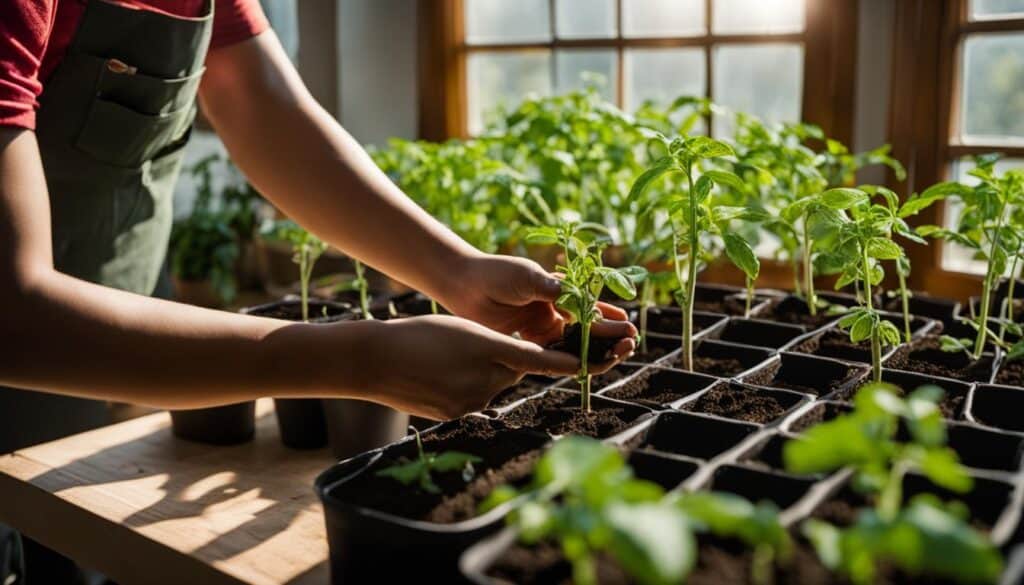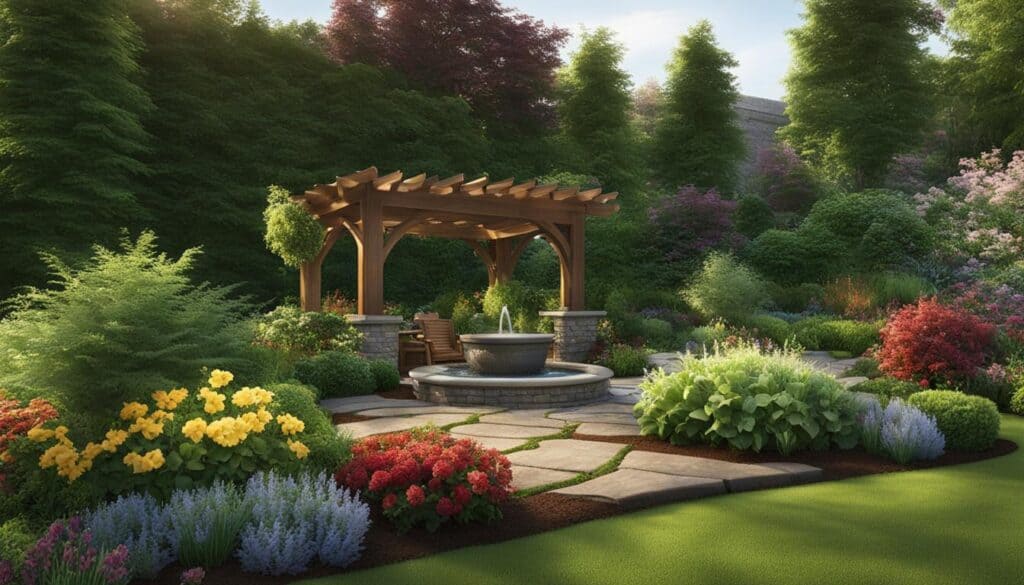Welcome to the world of home gardening! Whether you have a green thumb or are just starting out, this article is packed with easy gardening tips to help you create a beautiful and thriving garden right at home.
From choosing the right plants to maintaining and designing your garden, we’ve got you covered every step of the way. Let’s dive in and explore the wonderful world of home gardening together!
Key Takeaways:
- Starting small and gradually expanding your garden is key for beginners.
- Consider the climate and sunlight conditions when choosing plants.
- Proper plant care, including regular watering and fertilizing, is essential.
- Create an appealing garden design by focusing on color schemes and plant combinations.
- Adopt sustainable gardening practices to protect the environment.
Getting Started with Home Gardening

Are you ready to embark on your home gardening journey? Getting started is easier than you might think. By following a few simple steps, you’ll be well on your way to creating a thriving garden of your own.
First, choose a suitable location for your garden. Look for an area that receives ample sunlight and is easily accessible for watering and maintenance. Consider the size of your space and whether you want to plant directly in the ground or use containers.
Next, assess the quality of your soil. Good soil is the foundation for a successful garden. Test the pH level and make any necessary amendments to improve its fertility. You can find home soil testing kits at your local gardening store or consult with a professional for guidance.
Now it’s time to determine what types of plants you want to grow. Consider your climate and the amount of time you can dedicate to gardening. If you’re a beginner, start with easy-to-grow plants like herbs, salad greens, or tomatoes. As you gain confidence and experience, you can gradually expand your garden and experiment with more challenging varieties.
Invest in basic gardening tools such as a shovel, rake, trowel, and watering can. These essentials will make your gardening tasks easier and more efficient. Learn proper watering and fertilizing techniques to ensure your plants receive the care they need to thrive.
Remember, starting a home garden is an exciting journey of discovery and growth. With a little planning and dedication, you’ll soon be reaping the rewards of your own flourishing garden.
Choosing the Right Plants

When starting a home garden, one of the most crucial decisions you’ll make is choosing the right plants. It’s important to consider factors such as the available space, climate, and maintenance level before selecting the plants for your garden. By selecting the appropriate plants, you’ll increase the chances of a successful and thriving garden.
Factors to Consider
- Space: Evaluate the size and layout of your garden area to determine the number and types of plants you can accommodate. If you have limited space, consider vertical gardening or container gardening options.
- Climate: Research the climate in your region and choose plants that are suitable for your specific growing conditions. Some plants thrive in hotter climates, while others prefer cooler temperatures.
- Maintenance Level: Assess how much time and effort you’re willing to invest in plant care. If you’re a beginner or have limited time, opt for low-maintenance plants that require minimal attention.
Remember, the right plants for your garden will ultimately depend on your personal preferences and gardening goals. Take the time to research and choose plants that align with your vision for your home garden.
Whether you prefer flowers, vegetables, or a combination of both, there is a wide variety of plants to choose from. Consider consulting with gardening experts or visiting local nurseries for advice on suitable plant options for beginners.
Plant Care and Maintenance

Proper plant care is essential for the health and growth of your home garden. By providing the right care, you can ensure that your plants thrive and produce beautiful blooms or abundant fruits and vegetables. Here are some easy gardening tips to help you maintain your garden:
1. Watering
Watering is crucial for the survival of your plants. It’s important to water your garden regularly, especially during dry spells or hot summer months. However, avoid overwatering, as this can lead to root rot and other problems. Check the moisture level of the soil by inserting your finger into the ground. If it feels dry up to the first knuckle, it’s time to water. Use a watering can or a garden hose with a nozzle attachment to provide a gentle and even flow of water.
2. Fertilizing
Plants need nutrients to grow and stay healthy. Fertilizing your garden helps replenish these nutrients and promotes robust growth. Use a balanced fertilizer that contains essential nutrients like nitrogen, phosphorus, and potassium. Follow the instructions on the fertilizer package to determine the appropriate amount and frequency of application. Be careful not to over-fertilize, as this can harm your plants. Consider using organic fertilizers, such as compost or well-rotted manure, to nourish your plants naturally.
3. Pest Control
Protecting your garden from pests is crucial to prevent damage to your plants. Regularly inspect your garden for signs of pests, such as chewed leaves or droppings. Use organic pest control methods whenever possible to avoid harmful chemicals. For example, you can introduce beneficial insects like ladybugs or lacewings, which feed on common garden pests. Alternatively, create natural barriers by planting companion plants that repel pests or using physical barriers like netting or row covers.
By implementing these plant care and maintenance practices, you can ensure the long-term health and vitality of your home garden. Remember to observe your plants closely and make adjustments to your care routine as needed. With time and experience, you’ll become more confident in caring for your plants and enjoy the beauty and abundance they bring to your garden.
Garden Design and Layout

Creating a well-designed garden is an essential aspect of home gardening. It not only adds beauty to your outdoor space but also enhances its functionality. When planning your garden layout, consider factors such as color schemes, plant heights, and blooming times to create a visually appealing and harmonious environment.
One way to create visual interest in your garden is by incorporating focal points and paths. Focal points can be created using eye-catching elements such as statues, birdbaths, or small water features. Paths, on the other hand, can guide the eye and create a sense of flow throughout your garden.
Experimenting with different textures and combinations of plants can also add interest and variety to your garden. Consider using plants with different foliage colors, shapes, and sizes to create contrast and depth. For example, pairing plants with broad leaves with those with fine, delicate foliage can create an interesting visual contrast.
Consider the following tips when designing your garden:
- Choose a color scheme that complements your home’s exterior and the surrounding landscape.
- Plant taller-growing plants at the back of flower beds or borders to provide a backdrop for shorter plants.
- Plant flowers and plants with staggered blooming times to ensure continuous color throughout the seasons.
- Create seating areas or outdoor lounges to enjoy your garden and provide a place for relaxation.
- Investigate the growth habits and space requirements of your chosen plants to ensure they have enough room to thrive.
Remember, garden design is a personal expression of your creativity and style. Don’t be afraid to experiment and make changes as you go along. The most important thing is to create a garden that you love and that brings you joy.
With careful planning and consideration, you can design a beautiful and functional garden that will be a source of pride and enjoyment for years to come.
Sustainable Gardening Practices
Creating a sustainable garden is not only beneficial for the environment, but it also helps you maintain a healthier and more productive garden. By implementing eco-friendly practices, you can minimize the use of harmful chemicals and reduce waste. Here are some easy gardening tips to make your home garden more sustainable:
1. Use Organic Fertilizers and Pest Control Methods
Instead of relying on chemical fertilizers and pesticides, opt for organic alternatives. Use compost or organic fertilizers to nourish your plants naturally. Consider companion planting to deter pests and attract beneficial insects. You can also make your own organic pest control solutions using ingredients like neem oil or garlic.
2. Implement Water-Saving Techniques
Water is a precious resource, so it’s important to use it efficiently in your garden. Install a drip irrigation system to deliver water directly to the roots of your plants, minimizing water wastage. Collect rainwater in barrels or containers and use it to water your plants. Mulching can also help retain moisture in the soil, reducing the need for frequent watering.
3. Compost Kitchen Scraps and Yard Waste
Instead of throwing away your kitchen scraps and yard waste, compost them to create nutrient-rich soil for your garden. Set up a compost bin or pile and add organic matter like fruit and vegetable peels, coffee grounds, and grass clippings. Over time, the compost will break down into a dark, crumbly substance that can be used as a natural fertilizer.
Creating a sustainable garden not only benefits the environment, but it also creates a healthier and more resilient garden space. By following these easy gardening tips, you can reduce your environmental impact while enjoying the beauty and abundance of your home garden.
Troubleshooting Common Garden Problems
Even the most experienced gardeners encounter some common garden problems from time to time. Don’t worry, it’s all part of the learning process! Below are some tips to help you identify and address these issues:
- 1. Pests: Keep an eye out for common garden pests such as aphids, slugs, and snails. Use organic pest control methods like introducing beneficial insects or using natural repellents.
- 2. Diseases: Monitor your plants for signs of diseases such as powdery mildew or blight. Remove infected plants or treat them with appropriate fungicides to prevent the spread.
- 3. Nutrient Deficiencies: Yellowing leaves or stunted growth can indicate nutrient deficiencies. Test your soil to determine which nutrients are lacking and amend accordingly with organic fertilizers or compost.
- 4. Improper Watering: Overwatering or underwatering can cause stress to your plants. Ensure your plants receive the right amount of water based on their needs and the weather conditions.
If you’re unsure about the specific solutions for the plants in your garden, consult gardening resources or seek advice from local experts. Remember, troubleshooting is a normal part of the gardening journey, and with some patience and determination, you’ll overcome these challenges.
Expert Tip:
Prevention is key! Regularly inspect your plants for signs of problems, and take preventive measures such as proper spacing, good air circulation, and practicing crop rotation.
Harvesting and Enjoying the Fruits of Your Labor
Gardening is a labor of love, and one of the most rewarding moments is finally harvesting the fruits (and vegetables) of your hard work. As a beginner, it’s important to know when and how to harvest your crops to ensure the best flavor and freshness. Follow these easy gardening tips to make the most of your bountiful harvest:
- Timing is key: Each plant has its own ideal time for harvest. Research the specific harvesting guidelines for the plants in your garden to determine the best time to pick them.
- Use your senses: Check for visual cues like color and size to determine if a fruit or vegetable is ripe. Additionally, smell and touch are important indicators of ripeness. Trust your instincts and don’t be afraid to experiment.
- Handle with care: When harvesting delicate fruits and vegetables, such as berries or tomatoes, gently twist or cut them from the plant to avoid damaging them.
- Preserve your harvest: If you have an abundance of produce, consider preserving them through canning, freezing, or drying. This will allow you to enjoy the flavors of your garden all year long.
Quote: “The best part about harvesting your own fruits and vegetables is the unbeatable taste. Nothing can compare to the freshness and flavor of homegrown produce.” – Anonymous Gardener
Sharing the fruits of your labor is also a wonderful way to spread joy and connect with others in your community. Whether it’s a basket of freshly picked strawberries or a jar of homemade salsa, sharing your harvest with friends, family, and neighbors is a gesture that will surely be appreciated.
Maximizing Flavor and Nutrition
To truly savor the flavors of your homegrown harvest, it’s important to harvest fruits and vegetables at their peak ripeness. This is when they are not only the most delicious but also the most nutritious. Research suggests that fruits and vegetables that are allowed to fully ripen on the plant have higher levels of antioxidants and other essential nutrients.
So, take the time to observe your garden closely, checking for signs of ripeness and harvesting each crop at its prime. With practice, you’ll develop a keen eye for recognizing the perfect moment to pluck that ripe tomato or harvest that juicy melon.
Continuing Education and Inspiration
Gardening is a never-ending learning process, and there are always new techniques, trends, and innovations to explore. To stay updated and inspired, there are several resources and activities you can engage in.
1. Read Books and Magazines:
There are countless gardening books and magazines available that offer valuable information and inspiration. From beginner’s guides to advanced techniques, you can choose publications that cater to your interests and gardening level. Reading these materials will expand your knowledge and provide new ideas for your home garden.
2. Explore Online Resources:
The internet is a treasure trove of gardening information. Explore gardening websites, blogs, and forums to access a wealth of tips, advice, and firsthand experiences from seasoned gardeners. Online tutorials and videos can also be a great way to learn new techniques and get step-by-step guidance.
3. Join Gardening Clubs and Workshops:
Consider joining local gardening clubs or attending workshops in your community. These platforms provide opportunities to connect with fellow gardeners, share ideas, and gain hands-on experience. You can learn from experienced gardeners, participate in group projects, and even swap plants or seeds.
Creating a Garden Journal
Keeping a garden journal is a valuable practice for every beginner gardener. Not only does it serve as a record of your gardening journey, but it also helps you stay organized and learn from your experiences. By keeping track of important information like plant names, planting dates, and care schedules, you can easily reference it for future seasons and make improvements as needed.
What makes a garden journal even more valuable is the ability to reflect on your successes and failures. Use it to make notes on what worked well in your garden and what didn’t. This will help you identify patterns and make better decisions in the future.
“A garden journal is like a personal diary for your plants. It allows you to track their progress, document any issues or challenges you encountered, and ultimately learn from your own experiences.”
Additionally, a garden journal can serve as a source of inspiration. Include sketches or photographs of your garden, jot down ideas for future plantings or designs, and document any interesting observations or new techniques you come across. It’s a way to capture the beauty and joy of gardening and create a lasting memory of your unique garden.
Beyond Pen and Paper: Digital Options
For those who prefer a digital approach, there are numerous gardening journal apps and software available. These tools offer features like photo uploads, automatic reminders for watering and fertilizing, and even community forums where you can connect with other gardeners. Find a digital option that suits your needs and preferences, and enjoy the convenience and organization it brings to your gardening journey.
Remember, a garden journal is not just a record-keeping tool; it’s a reflection of your passion for gardening and a way to continually improve your skills. So grab a notebook or download an app, and start documenting your gardening adventures today!
Conclusion
Congratulations on taking the first step towards creating a beautiful and thriving home garden! With these easy gardening tips for beginners, you’ll be well on your way to becoming a successful gardener. Remember, home gardening is a journey filled with learning and experimentation, so don’t be afraid to get your hands dirty and try new things.
Starting small is key when it comes to home gardening. As a beginner, it’s important to choose plants that are suited to your growing conditions and that require minimal maintenance. Take the time to assess your garden’s location and soil quality, and invest in the necessary gardening tools.
Proper care and maintenance are essential for the health of your garden. Learn about the specific needs of each plant, including watering, fertilizing, and pest control. Regularly inspect your plants for any signs of disease or pests, and take swift action to address these issues.
Finally, remember that gardening is a labor of love. Enjoy the process and take pleasure in the fruits of your labor. Whether it’s harvesting your first crop or sharing the bounty with loved ones, your home garden will bring you joy for years to come. So, grab your gardening gloves and get ready to embark on this exciting and rewarding journey!
 Fullersears
Fullersears





